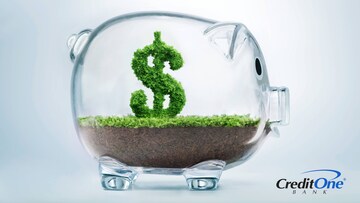
How to Affordably Invest in Eco-Friendly Home Upgrades
October 11, 2023
Topics:
Financial TipsLearn what eco-friendly home upgrades can offer you the best return on investment and discover how to finance them.

The emphasis on sustainability has grown over the last few years, with no signs of slowing down. And while making your home eco-friendly comes with a cost — some upgrades more than others — doing so can yield long-term benefits both for the environment and your finances.
Luckily, there are ways to help minimize the upfront costs while still doing your part to help the environment.
Financial Benefits of an Eco-Friendly Home
Aside from the environmental benefits of having an eco-friendly home, your bank account can see some gains as well … giving the phrase “going green“ a whole new meaning.
- Lower utility bills – The less water, electricity, and gas you use, the less those bills will cost.
- Lower maintenance costs – The more sustainable and durable the materials in your house, the less maintenance required.
- Higher resale values – With a growing societal emphasis on sustainability, home buyers may have an eye out for eco-friendly properties. If you’re selling a home that already has these features, you’re in a pretty advantageous spot. Supply and demand, baby.
Financing Your Eco-Friendly Home Upgrades
Unfortunately, eco-friendly upgrades can be expensive. So much so that homeowners may delay or cancel the upgrades because the cost might be too prohibitive. Luckily, there’s a variety of options to help you find the green to go green.
Tap into your personal savings
One way to pay for those eco-friendly upgrades is to use your personal savings account. The nice thing about paying with your own cash — as opposed to borrowing — is you don’t get stuck with any high-interest debt. Plus, you’re also ensuring you can actually afford the purchase because you know exactly what you have to spend.
You may already have a hefty-enough savings account and the wiggle room in your budget to pay for a home upgrade or two. But if you need to spend some time to save up, regularly setting aside money into a savings account until you get to your goal is a solid way to save for the cost of any upgrades. If it’s a high-yield savings account with a high interest rate that allows you to grow your money quicker, even better.
Regardless of the path, there are a couple of things to keep in mind before dipping into your savings.
- Will you still have enough for an emergency fund? Experts recommend having three to six months of living expenses in an emergency fund. If pulling from your savings means sacrificing this safety net, you may want to reconsider.
- Do you have any high-interest debt? If you’ve already got some debt, perhaps hold off on the home upgrades and take care of that first.
Use your home equity
You can also tap into the equity of your home — the difference between your home’s value and your mortgage balance — to finance your upgrades, either by taking out a second mortgage or by refinancing.
Two examples of second mortgages are home equity loans and home equity lines of credit.
- With a home equity loan, you use the equity in your home as collateral to receive a lump-sum payment that you have to pay back at a fixed interest rate over an agreed period of time. However, while the lump sum can be useful for paying for a home improvement project, it also comes with risk. Since the loan is secured by your home, you chance losing it if you cannot pay it back. Plus, if real estate values decrease, you could end up owing more than your home is worth.
- With a home equity line of credit (HELOC), you borrow against the equity in your home to open a line of credit. As you repay your balance and any accrued interest, the available credit is replenished, much like a credit card. You can borrow as little or as much as you need (up to the credit limit) throughout the established draw period. Once the draw period ends, your repayment period begins. This option could be useful if you have an ongoing project and aren’t sure how much money you’ll need. However — similar to a home equity loan — since your home is serving as collateral for the HELOC, if you’re unable to pay it back for any reason, you risk losing your home to foreclosure.
An example of refinancing is cash-out refinancing.
- With cash-out refinancing, you take out a new mortgage that pays your existing loan off and leaves you with a lump sum of cash based on the amount of equity in your house. The old mortgage loan is replaced by a new one with different terms. Some drawbacks of this option include high closing costs and receiving a new loan with a higher interest rate than before.
It’s important to note the differences between taking out a second mortgage vs. refinancing.
With a second mortgage, you’re:
- Not changing the terms of your original loan
- Adding another payment to your monthly budget
When you refinance, you’re:
- Getting a whole new loan with different terms
- Only making a single payment each month … the new mortgage
Apply for an FHA loan
The Federal Housing Administration’s (FHA) Energy Efficient Mortgage Program provides the ability to finance energy efficient improvements. Under this program, the FHA insures your mortgage used to purchase or refinance your home and the cost of energy-efficient improvements to be made on the home. Those improvements must be “cost effective,” meaning the cost of making the upgrades needs to be equal or less than the money saved on energy from those improvements.
Consider a personal loan
Personal loans can be used for a number of purposes, including home upgrades. You receive the loan amount in a lump sum and pay it back through monthly payments over a set period of time with a fixed interest rate.
Pros:
- Can help you build credit (assuming on-time payments for the life of the loan)
- No collateral requirement
- Can be used for almost anything
- Has a fixed interest rate
Cons:
- Creates additional debt that must be paid off
- May come with fees and penalties
- Might have higher interest rates than other types of loans
- Can negatively impact your credit if you miss payments or through a hard inquiry during application
Look into manufacturer financing options
Sometimes you may be able to go straight to the source for financing. Some manufacturers and installers of eco-friendly home improvement products — such as HVAC systems or solar panels — may provide their own financing options that allow you to get the desired upgrade and pay it off over time.
Put it on a credit card
As long as you use them responsibly, credit cards can also be an option.
Pros:
- Welcome bonuses and rewards programs – Many credit cards offer welcome bonuses (points, cash back rewards, etc.) for hitting a certain spend threshold within a certain amount of time after opening the card. So funding a large purchase can help you hit that bonus quickly as long as you have a big enough credit limit. Many cards also offer points or cash back rewards for all purchases or for certain categories.
- Convenience – Using a credit card is one of the most convenient ways to make purchases.
- Protections – Some cards come with purchase protections and extended warranties, which provide an extra layer of security on your big purchases in case they’re damaged or stolen.
- Credit building – Assuming timely payments, using a credit card is a great way to boost your credit score.
Cons:
- Overspending – While convenience is a pro, it can also become a con. Easy access to a credit card can lead to spending beyond your means if you’re not careful.
- Fees and interest – Carrying a balance can result in being charged interest at a rate higher than other financing options. Plus, credit cards can lead to fees either from the issuer for things like late payments or from the vendor just for using a card. In fact, a lot of contractors won’t take credit cards without charging you a 2%-3% fee. So you’ll end up paying more than the cost of the purchase.
- Credit impact – Where timely payments can raise your credit score, the opposite is also true. Missing or not making payments can bring your credit score down. Maxing out your card can give you a higher credit utilization ratio and hurt your credit as well.
If you’re in the market for a credit card, it’s important to do a little comparison shopping. There are a lot of options, each with their own unique features … you just have to find the right card for you. And remember that applying for a credit card is a hard inquiry on your credit report. So keep an eye out for pre-approval offers or see if you pre-qualify first, both of which carry soft inquiries and won’t impact your credit score.
And, as always, it’s important to factor in your financial situation before you use your plastic for a home upgrade. If you already carry debt and don’t have a good credit score as a result, it may not be the best idea to add to the situation by charging a high-priced item until you have a plan to resolve what’s already there.
Which Eco-Friendly Home Upgrades Offer the Best ROI?
So, what are some examples of eco-friendly home upgrades that may provide a strong return on your investment?
- Energy efficient doors and windows can add curb appeal and improve energy efficiency at the same time, saving you money and helping the environment. The more insulated your doors and windows are (against heat in the summer and cold in the winter), the less you’re going to pay to cool or heat your home.
- A tankless water heater heats water as needed rather than holding hot water in a tank and wasting energy to do so. They use less energy on a daily basis which lowers your energy bill plus they help add to the resale value of your home.
- LED lightbulbs not only use less energy but last longer, saving you money in the process.
- Solar panels, while expensive, can pay huge dividends. Imagine saying goodbye to your electric bill! Plus, they’re a great selling point to potential homebuyers.



